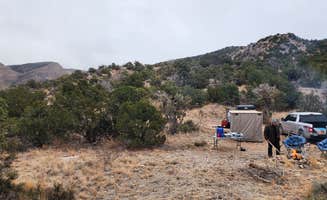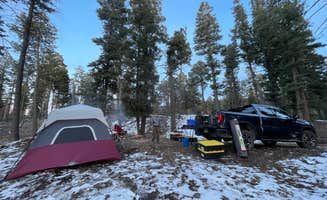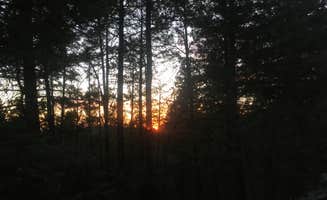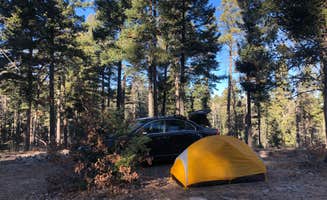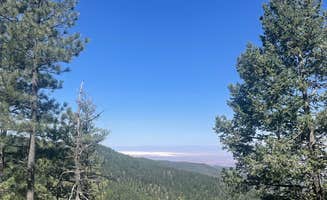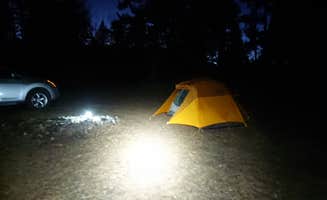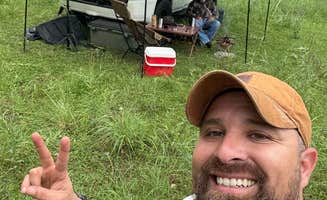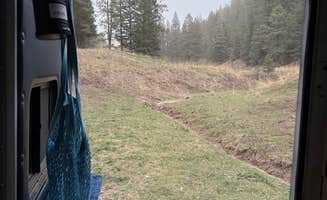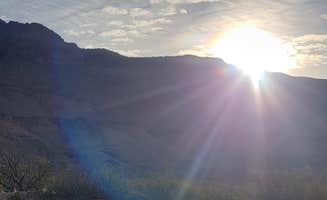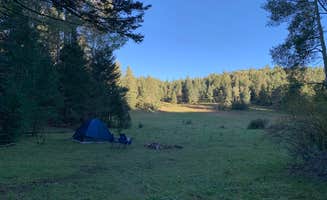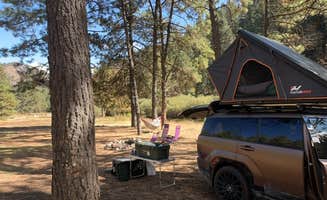Dispersed camping near Tularosa, New Mexico offers significant temperature variations depending on elevation, with areas in Lincoln National Forest often experiencing frost well into spring. Most dispersed sites lack waste disposal facilities, requiring campers to pack out all trash and waste. Forest road conditions deteriorate quickly after rainfall, with many access points becoming challenging even for high-clearance vehicles during wet periods.
What to do
Explore Waterfall Hikes: At Bluff Springs Dispersed Camping, visitors can access short hiking trails leading to a small waterfall. "There is a small waterfall that we could see and hear from our campsite and a creek for kiddos to play in. Its a free range area so cows are all over the place which was fun to see," notes one camper.
Wildlife Observation: Forest Road 568 provides excellent wildlife viewing opportunities, particularly in early morning or evening hours. "We drove in around 10pm and the small town of Cloudcroft was beautiful for anyone needing a place to stop before heading into the forest. We saw more elk than we could count! Just glowing eyes everywhere and all in the road," reports a visitor.
Star Gazing: The minimal light pollution at many dispersed sites creates ideal conditions for astronomy. At Dog Canyon, one camper shared, "Easy to access, plenty of spots along the main road and other spurs going off from it. Drove the whole way until it dead ends into State Park land (fenced) then turned around and went down a spur on the left to a great spot. Verizon service, starry skies."
Mountain Biking: Forest trails near Cloudcroft provide numerous biking opportunities across varied terrain. Some routes connect directly to dispersed camping areas, allowing riders to start directly from camp. Riders should be prepared for elevation changes and rocky surfaces on most trails.
What campers like
Temperature Relief: The higher elevation sites provide significant temperature relief during summer months. At Lincoln NF - Forest Service Road 64, campers report, "We tent camped in mid September 2022 in the Lincoln National Forest south of Cloudcroft, NM off Forest Service Road 64. Over 9,400' and it got cold at night. Saw one elk and heard more bugling."
Privacy Options: Many sites offer seclusion despite overall popularity. "We planned on only staying up here a couple days, but plans off the mountain fell through and we stayed for 12. It was gorgeous. Huge forest with lots of exploring to do. We got a nice little private spot under a huge tree," notes a visitor to Forest Road 568.
Cell Service Variability: Some sites maintain surprisingly good connectivity. A camper at Forest Road 568 - Dispersed Camping found, "Arrived around 6 pm on a Tuesday evening. Took a right at the fork (sweet group campsite there but occupied) and stayed the night at a pull off to the left, about halfway up the hill. I had AT&T 3-4 bars of signal, enough to work my remote job and stream You-Tube."
Established Fire Rings: Most dispersed sites feature rock fire rings left by previous campers, eliminating the need to create new fire pits. This reduces environmental impact while still allowing for campfires where permitted.
What you should know
Site Availability Timing: Weekends see significantly higher usage, particularly in summer. "Been camping here several times a year and it just keeps getting busier and busier. Need to find a new place!" notes a visitor to Bluff Springs. Arriving mid-week dramatically increases site selection options.
Road Conditions: Many access roads require careful navigation. At Dry Canyon Near Hang Glider Launch, "The camping is great and the views are amazing. However, the trail up to the camping spots is steep, washed out, and tight. Can be navigated with a stock 4x4 pick up."
Wildlife Precautions: Proper food storage is essential with active wildlife in the area. "We saw more elk than we could count! Just glowing eyes everywhere and all in the road," reports a camper. Secure food in vehicles overnight to prevent attracting animals.
Noise Considerations: Some areas experience unexpected noise issues. "This is right off of highway 244. From CloudCroft take highway 82 east to highway 244 about half mile past designated campgrounds is a dirt road to the left. There is a large grass/dirt area right off the road on the left and a couple of spots further down. To the right there are a couple of more 'secluded' spots though the generator noise and the chainsaws are still loud."
Tips for camping with families
Creek Access Sites: Look for camps near water features for built-in recreation. "This was my husband and I's first experience boondocking and we were looking for a location close enough to the White Sands National park that wouldn't be to far of a drive and this location was perfect. Clean, Quiet and Beautiful. We enjoyed seeing all the rock trails that have been created from previous visitors," notes a Dog Canyon visitor.
Wildlife Viewing Opportunities: Many sites offer animal sightings that appeal to children. "Its a free range area so cows are all over the place which was fun to see," reports one Bluff Springs camper, while another mentioned, "We also found a lot of bones from dead animals which was pretty cool."
Accessibility Considerations: Some sites require minimal hiking from parking areas. At Alamo Peak Rd, "Rim Trails and Alamo Peak Trails in walking distance. There were other campers nearby but it was quiet and beautiful. Elk, hummingbirds, all tucked away in aspen grove. This is a special spot."
Safety Awareness: Some areas have unique safety concerns. "At 1am as I was sleeping in my car, a UTV pulled up behind my vehicle and started flashing their lights. I quickly drove but they followed me down the dirt road," reports one Dog Canyon camper, highlighting the importance of situational awareness.
Tips from RVers
Length Limitations: Many forest roads have limited turnaround options for larger rigs. "This was a beautiful location, near the town of Cloudcroft. We enjoyed the cooler weather up in the mountains. It was peaceful and quite. There were not very many spaces available. We should have have just stayed in the first location we found though. We went to the end of the road to find out that there was no way to turn our 29 ft trailer."
Leveling Challenges: Prepare for uneven terrain at most sites. "One of our favorites. Room for big rigs prior to road intersection pretty rough beyond that. Able to get our 31' class C with no issues other than unevenness. The good: beautiful tree coverage, trails that lead to town, road biking distance to town, daily short rains, wild mustangs walking right through our site, plenty of room. The bad: rocky unlevel sites."
Site Selection Strategy: Select sites with adequate clearance and maneuvering space. "We have a 30 foot motor home and were so glad to find a dispersed spot in the mountains we could fit!" shares an Alamo Peak Rd visitor, showing that larger rigs can access some areas with careful site selection.
Surface Conditions: Be prepared for dust and road conditions affecting campsite comfort. "Beware of the dust coming from the road! The winds can be strong and will sweep the dust into your camp," advises a Bluff Springs camper.


